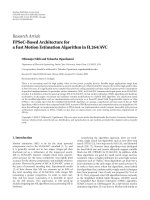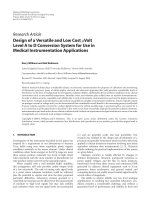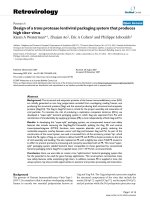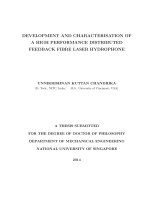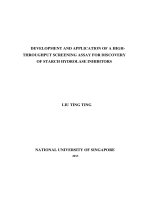System on chip design of a high performance low power full hardware cabac encoder in h 264 AVC
Bạn đang xem bản rút gọn của tài liệu. Xem và tải ngay bản đầy đủ của tài liệu tại đây (2.12 MB, 200 trang )
SYSTEM-ON-CHIP DESIGN OF A HIGH
PERFORMANCE LOW POWER FULL
HARDWARE CABAC ENCODER IN
H.264/AVC
TIAN XIAOHUA
(M.Eng, HUST)
A THESIS SUBMITTED FOR THE DEGREE OF PH.D.
DEPARTMENT OF ELECTRICAL AND COMPUTER ENGINEERING
NATIONAL UNIVERSITY OF SINGAPORE
2009
ii
Acknowledgements
First of all, I would like to thank my supervisors Dr. Le M. Thinh and Prof. Lian Yong
for their advices, encouragement, and long-term supports during my Ph. D. study and
research work. Without these two great mentors, I would not complete my research work
successfully.
Thanks to the colleagues of our research group including Mr. Jiang Xi, Ho Boon Leng,
Shyam Krishnamurthy, Hong Zhiqian, Thu Trang, Esmond Teo Haochun, and John
Nankoo for their supports, suggestions, and helpful discussions. Without them, I could
not build up the complete scheme of this CABAC encoder design of my thesis.
Thanks to my friends in VLSI lab including Wei Ying, Zhang Wenjuan, Zhu Youpan,
Chen Xiaolei, Zhang Xiaoyang, Bai Na, Zhang Jinghua, Yang Zhenglin, Pu Yu, Zou
Xiaodan, Xiaoyuan, Wu Liqun, Yu Heng, Li Yanhui, San Jeow, Cheng Xiang, Tan Jun,
Chang Xiaofei, Niu Tianfang, Wang Lei, Qiu Lin, Raja, Amit, Lynn, John, Shakith, my
seniors Yu Jianghong, Yu Rui, Chen Jianzhong, He Lin, Hu Yingping, Tong Yan, Cen
Lin, Gu Jun, and many others.
Thanks for the valuable advices and help from Mr. Jiang Xiping, Dr. Ha Yajun, Prof. Xu
Yong Ping, Ms. Zheng Huanqun, Mr. Teo Seow Miang, Prof. Zhu Minghua, et al. for my
research work.
Finally, I would like to thank my dear Father and Mother, my Grandma, uncles and aunts,
Wenxiu, Liu Yu, Tian Jun, Xiang Li, Tian Zhenzhen, Li Jie, Li Chi, Fang Congbiao, my
friends Wang Enbo, Zhou Jinxin, Liu Chunhui, Zhang Jing, Teng Mingqing, Wen Qiang,
Liang Kun, et al. for their encouragements that support me to complete this thesis.
iii
Abstract
Context-based Adaptive Binary Arithmetic Coding (CABAC) is the entropy coding tool
adopted in Main and High profiles of H.264/AVC video coding standard. CABAC
provides significantly higher compression ratio than Baseline profile entropy coder
CAVLC. Rate-Distortion Optimization (RDO) is another important technique that
improves the encoding performance of H.264/AVC. It is necessary to support both
CABAC and RDO in the high quality and high definition H.264/AVC applications;
however, this results in significantly increased computational complexity. Due to the
sequential coding nature of CABAC with strong data dependency and frequent memory
access, it is not efficient to accelerate CABAC encoding by software optimization.
Therefore, hardware acceleration of CABAC encoding is necessary in the high bit-rate
real time video encoding. This work focuses on high performance circuit design of
CABAC encoder IP targeting at Main Profile of H.264/AVC.
SoC-based design flow is explored during the CABAC encoder IP design, including steps
of encoder performance and complexity analysis; system specification; HW/SW
partitioning that minimizes computation complexity on the host processor and data
transfer on system bus; HW functional partitioning that maximizes encoding parallelism;
HW function block design; SoC feature insertion including system bus interface and
interconnection IP design; circuit implementation and verification, etc. The encoder is
designed and fully verified at RTL level, gate level, and post-layout stage targeting at
0.13um CMOS process. FPGA prototyping is also completed successfully.
iv
In order to accelerate sequential and highly data dependent procedure of CABAC and
optimize circuit performance, various design methodologies are explored in this work,
including: prefetch and local buffering for frequent accessed data to reduce data fetch
delay; precalculation to reduce critical path length; pipeline implementation of complex
sequential computation steps to achieve higher clock frequency; SRAM access
optimization with context line access & buffering and context RAM reallocation to
significantly reduce RAM access frequency and dynamic power; parallel processing of
function blocks of different throughput with FIFO insertion; system power reduction with
clock gating insertion, etc.
This work provides the only reported CABAC encoder design that achieves high
processing speed of real time coding in CIF format full RDO mode and in HDTV 720p
format RDO-off mode. The compression efficiency of the proposed encoder is the best
compared to the reported designs, because of solving design difficulty of CABAC coding
in RDO mode. Encoder power consumption is the lowest, consuming only 0.79 mW at
HDTV 720p60 8.9 Mbps RDO-off mode coding. Only this work provides complete SoC-
based IP solution of CABAC encoder that can efficiently support different H.264 coding
configurations including RDO-off, fast RDO, and full RDO mode, and the application
range of the IP is wider, from real time coding to high quality compression. This work
enhances performance of both CABAC encoder and H.264 video coding system and
achieves global performance optimization, with utilization of encoder design flexibility.
v
Table of Contents
Acknowledgements ii
Abstract iii
List of Figures ix
List of Tables xii
Chapter 1 Introduction 1
1.1 Overview of H.264/AVC Standard 1
1.2 Approaches of H.264/AVC Codec Acceleration 9
1.3 Objectives of the Research 10
1.4 List of Publications 12
Chapter 2 Review of Arithmetic Coding and CABAC 14
2.1 Introduction of Arithmetic Coding 14
2.2 CABAC of H.264/AVC 16
2.2.1 Binarization 17
2.2.2 Context Modeling 19
2.2.3 Binary Arithmetic Coding (BAC) 21
2.2.4 Comparisons of CABAC with Other Entropy Coders 24
Chapter 3 Review of Existing CABAC Designs 26
3.1 CABAC Decoder and Encoder IP designs of H.264/AVC 27
3.1.1 CABAC Decoder Designs 27
3.1.2 CABAC Encoder Designs 32
3.2 Summary of Implementation Strategies of Entropy Codecs 37
Chapter 4 The Proposed Design of Hardware CABAC Encoder 39
4.1 Design Methodology of SoC-based Entropy Coder 39
4.1.1 Performance & Complexity Analysis of CABAC Encoder 42
vi
4.2
HW/SW Functional Partitioning of CABAC Encoder 46
4.2.1 Analysis of Different Partitioning Schemes 47
4.2.2 RDO Function Support in HW CABAC Encoder Design 51
4.3 Top-level HW Encoder Functional Partitioning 53
4.3.1 Proposed Hardware Functional Partitioning Scheme 55
4.3.2 Full-Pipelined Top-level HW CABAC Encoder Architecture 60
4.3.3 Date Dependency Removing & Encoding Acceleration 63
4.4 Binarization and Generation of Bin Packet 65
4.4.1 Input SE Parsing & Binarization of Unit BN 65
4.4.2 Bin Packet Generation and Serial Output of Unit BS&CS
2
70
4.5 Binary Arithmetic Coding (BAC) 72
4.5.1 Proposed Renormalization & Bit Packing Algorithm 73
4.5.2 Coding Interval Subdivision & Renormalization of Unit AR 76
4.5.3 Bit Packing of Unit BP 77
4.6 Additional Functions of CABAC Encoder 79
4.6.1 Context Model Initialization 79
4.6.2 RDO Function Support in BAC 80
4.6.3 FWFT Internal FIFO buffers 80
Chapter 5 Efficient Architecture of CABAC Context Modeling 82
5.1 Context Model Selection 82
5.1.1 Scheme of Storage & Fast Access of Coded SEs of IC Sub-unit 83
5.1.2 CtxIdxInc Calculation (IC) of Unit CS
1
91
5.1.3 Memory Access (MA) sub-Unit of Unit CS
1
98
5.2 Unit CA: Efficient Context Model Access 101
5.2.1 Context Line Access & Local Buffering 101
5.2.2 Context RAM Access Scheme Supporting RDO-on Mode 104
5.2.3 Context Model Reallocation in Context RAM 106
5.3 Context State Backup & Restoration in P8×8 RDO Coding 107
5.4 Coded SE State Backup & Restoration of Unit CS
1
111
vii
5.5
Summary 113
Chapter 6 System Bus Interface and Inter-connection Design 115
6.1 Introduction of the WISHBONE System Bus Specification 115
6.1.1 Interface Signals of the WISHBONE System Bus 115
6.1.2 Types of Bus Cycles on the WISHBONE System Bus 117
6.1.3 Comparison of WISHBONE and AMBA System Buses 118
6.2 Design of WISHBONE System Bus Interfaces for CABAC Encoder 119
6.2.1 Functional Partitioning of WISHBONE System Bus Interfaces 119
6.2.2 Analysis of Support of WISHBONE Registered Feedback Cycles 120
6.2.3 Design of Slave Interface of WISHBONE System Bus 122
6.2.4 Design of Master Interface of WISHBONE System Bus 124
6.2.5 Consideration of Data Transfer Speed of System Bus 127
6.3 Design of System Bus Inter-connection (INTERCON) 128
6.3.1 Design of WISHBONE Crossbar INTERCON 128
6.3.2 Compact SoC-based CABAC Encoding System 133
Chapter 7 Design, Synthesis, and Performance Comparison 135
7.1 Design & Verification Flow of CABAC Encoder HW IP 135
7.1.1 Steps in Designing a CABAC Encoder 135
7.1.2 Functional Verification of CABAC Encoder 137
7.2 Results of Synthesis and Physical Design 141
7.3 Power Reduction Strategies & Power Consumption Analysis 145
7.4 MBIST Circuit of Memory Block of CABAC Encoder 149
7.5 Performance Comparison 151
7.5.1 CABAC Encoding Speed Performance of the Encoder 151
7.5.2 Performance Comparison of Context Model Access Efficiency 155
7.5.3 Performance Comparison with the State-of-the-Art Design 165
Chapter 8 Conclusions 170
8.1.1 Summary of Design Advantages 170
8.1.2 Future Research Directions 175
viii
Bibliography 178
ix
List of Figures
Figure 1-1: Block diagram of MB processing in H.264/AVC. (a) MB encoding, (b) MB
decoding 4
Figure 1-2: MB partition modes and sub-MB partition modes of ME in H.264/AVC 6
Figure 2-1: Coding interval subdivision of binary arithmetic coding 15
Figure 2-2: Block diagram of CABAC encoder [6] of H.264/AVC 17
Figure 2-3: Coding interval subdivision and selection procedure of CABAC. 21
Figure 2-4: Coding interval subdivision and selection of regular bin of CABAC. 22
Figure 2-5: Pseudo-C program of renormalization and bit output of CABAC 22
Figure 2-6: Decision of bit output and accumulation of outstanding (OS) bit. 24
Figure 3-1: Block diagram of CABAC decoder. 28
Figure 4-1: SoC-based entropy coder design flow. 40
Figure 4-2: Five CABAC functional categories as % of total CABAC instructions in CIF
test of H.264/AVC encoder of JM reference SW in the QP range of 12 to 36 44
Figure 4-3: Five schemes of HW/SW partitioning of CABAC encoding. 47
Figure 4-4: FSM-based HW CABAC encoder partitioning scheme. 54
Figure 4-5: Proposed HW CABAC encoder partitioning scheme 56
Figure 4-6: Block diagram of top-level architecture of HW CABAC encoder. 60
Figure 4-7: Input packet format of CABAC encoder. 65
Figure 4-8: Procedure for parsing and binarization non-/residual SE and control
parameters of unit BN, Block 1. 67
Figure 4-9: HW-oriented EGk binarization algorithm 69
Figure 4-10: Fast EGK binarization implementaion. (a) EG3 binarization for the suffix of
MVD; (b) EG0 binarization for the suffix of abs_level_minus1 70
Figure 4-11: Architecture of unit BS&CS2: (a) CtxIdx calculation and bin packet serial
output circuit for all SE, excluding SCF and LSCF; (b) CtxIdx calculation and SE serial
output of SCF and LSCF packet of residual coefficient block. 71
Figure 4-12: Three-stage pipeline implementation of renormalization and bit packing
algorithm in unit AR and unit BP. 75
Figure 4-13: Architecture of unit AR 76
Figure 4-14: Two-stage design of bit packing. 78
Figure 5-1: Block diagram of unit CS
1
, including MA sub-unit and IC sub-unit 83
x
Figure 5-2: Reference MBs on the top and left of current MB, and storage of 3 categories
of coded SEs (MB, 8×8 sub-MB, and 4×4 block) in the reference BPMB of current and
reference MBs 84
Figure 5-3: Fast access of neighboring coded block and sub-MBs. (a) Access of
neighboring luma 4×4 blocks, and (b) access of neighboring 8×8 sub-MBs and chroma
4×4 blocks of 4:2:0 video format 86
Figure 5-4: Functions of IC sub-unit of unit CS
1
92
Figure 5-5: MB processing in MA sub-unit and IC sub-unit of unit CS
1
99
Figure 5-6: Operations of MA sub-unit in the first 3 cycles of MB
N,M-1
processing 100
Figure 5-7: Architecture of unit CA with pipelined context line access and local buffering
scheme 102
Figure 5-8: Architecture of memory access control of unit CA in both RDO-off and
RDO-on mode 104
Figure 5-9: Reallocation of context model in context RAM (Normal RAM). Context
models of Normal RAM are illustrated as two continuous parts in the figure. 107
Figure 5-10: Four types of pipelined context state backup & restoration operation in P8×8
RDO coding. 110
Figure 6-1: Point-to-point inter-connection of single master & slave of the WISHBONE
system bus 116
Figure 6-2: One classic cycle of a WISHBONE master interface with registered feedback
of cycle termination. 121
Figure 6-3: Illustration of constant address burst cycle of WISHBONE slave interface.
123
Figure 6-4: Data output control of WISHBONE master interface with 32-bit dat_o bus.
126
Figure 6-5: Data output control of WISHBONE master interface with 8-bit dat_o bus. 127
Figure 6-6: Top-level architecture of 4-channel crossbar INTERCON of WISHBONE
system bus 130
Figure 6-7: Round-robin arbitration of master that connects to the slave. 131
Figure 6-8: Architecture of M0 sub-unit: (a) Generation of cyc signals of 4 slaves that can
connect to the master, and (b) selection of master input signal including dat_i and ack_i.
132
Figure 6-9: A compact inter-connection of CABAC encoder with other components of
video encoder 133
Figure 7-1: Design steps of CABAC encoder 136
Figure 7-2: Verification of the HW IP block 138
Figure 7-3: FPGA implementation and verification platform 141
xi
Figure 7-4: Chip Layout of the CABAC Encoder. 145
Figure 7-5: BIST testing circuits of memory block, including RAM BIST and ROM BIST.
149
Figure 7-6: Context RAM access frequency ratio of this design over [93], during RDO-
off coding in the QP range of 12 to 32 of 4 typical video sequences. 157
Figure 7-7: Context RAM read and write frequency access ratio of this design over [93],
during RDO-on coding. The average access ratios of I, P, and B frames of 4 video
sequences in QP range of 12 to 32 are shown. 159
Figure 7-8: Context RAM access frequency ratio of this design over [93] during RDO
coding in the QP range of 12 to 32 of 4 video coding sequences. Read ratio of I, P, and B
frames are illustrated in (a), (c), and (e) respectively; Write ratio of I, P, and B frames are
illustrated in (b), (d), and (f). 160
Figure 7-9: Context state backup & restoration operation delay ratio of this design to [93]
in P8×8 RDO coding for QP 12 to 32 of 4 video coding sequences. Ratio of P frame
coding in (a) and ratio of B frame in (b) 163
Figure 7-10: Average context RAM access number per frame of residual SEs in [95]
(compared design) and this design in CIF frame coding for QP 12 to 32. The access
numbers of RDO-off coding and RDO-on coding are shown in (a) and (b), respectively.
167
xii
List of Tables
Table 4-1: H.264/AVC encoder bit rate reduction, with CABAC compared to with
CAVLC 43
Table 4-2: Five function categories of CABAC encoder of instruction-level analysis 44
Table 4-3: Percentage of instructions of each category of CABAC encoding function in
CIF sequence analysis 45
Table 4-4: Percentage of instructions of each category of CABAC encoding function in
HDTV 720p sequence analysis 45
Table 4-5: Bit rate reduction of H.264/AVC encoder, using RDO-on mode compared to
RDO-off mode 51
Table 4-6: Computation complexity of CABAC encoder in RDO-off/RDO-on mode 52
Table 5-1: Fast table lookup of block index of neighboring block on the left or top of
current block for block level SE processing 87
Table 5-2: Fast table lookup of Block/sub-MB index of neighboring Chroma block/8×8
sub-MB on the left or top of current block/8×8 sub-MB 87
Table 5-3: Fast table lookup of sub-MB index of neighboring block on the left or top of
current block based on current block index 88
Table 5-4: Storage of coded SEs of top/left reference MBs 90
Table 5-5: Parameters of reference BPMBs required for CtxIdxInc calculation of
different types of SEs 93
Table 5-6: Classification of MB type and stored values of MB type 95
Table 5-7: Numbers and positions of blocks that need to store coded MVD of different
MB/sub-MV partition modes 96
Table 5-8: Types, bit Numbers, and usage descriptions of backup values of SEs of 8×8
sub-MB during P8×8 RDO coding 112
Table 6-1: Signals of WISHBONE master interface 117
Table 6-2: Type of register feedback cycles of WISHBONE classified by cti_o 120
Table 6-3: Configuration of coded bytes output order of RDO-off coding 125
Table 7-1: Testing vectors of CABAC encoder at different design steps 139
Table 7-2: Encoding pipeline throughput, max frequency, area of CABAC encoders 143
Table 7-3: Gate-level power consumption (mW) of reported designs and proposed design
146
Table 7-4: Power consumption of the proposed encoder in 3 video coding configurations
147
xiii
Table 7-5: Distribution of power consumption of the proposed CABAC encoder in RDO-
on / RDO-off mode coding 148
Table 7-6: Speed-up of CABAC encoding of the HW IP compared to SW 153
Table 7-7: Average throughput of the proposed CABAC encoder in video coding tests154
Table 7-8: Average context RAM access frequency ratio (This design over [93] in RDO-
off mode coding) 156
Table 7-9: Reduction of RAM access frequency of the proposed encoder, attributed to
Context RAM reallocation 157
Table 7-10: Average context state backup and restore operation delay ratio of the
proposed design to [93] 164
Table 7-11: Functional comparisons of [95] and the proposed design 165
Table 7-12: Context access performance (number of RAM access) of the proposed
encoder compared to [95] in residual SE coding 167
Chapter 1 Introduction
1
Chapter 1 Introduction
Video coding technology has significantly changed the daily life of human beings in the
last two decades. A variety of software/hardware applications of video coding technology
have emerged recently. Because uncompressed video signals require huge amount of data
storage and network bandwidth, video coding technologies are necessary to compress
original video signals to reduce redundancy in spatial, temporal, and code word domain.
Several video coding standards have been established since 1980’s to specify video
coding techniques utilized for different applications, including H.261 [1], MPEG-1 [2],
MPEG-2 [3], H.263 [4], MPEG-4 Part 2 [5], and H.264/AVC [6]. H.261 is the first video
coding standard targeting at low delay, slow motion applications such as video
conference. MPEG-1 introduces half-pixel motion estimation and bi-direction motion
estimation (ME), with perceptual-based quantization, similar to JPEG [7]. MPEG-2 (also
known as H.262) supports interlaced video format and broadcasting quality video coding.
H.263 achieves a significant improvement of video compression especially at low bit rate,
with more efficient ME and techniques of variable block size ME and arithmetic coding
adopted in H.263 Annex. MPEG-4 Part 2 adopts ¼-pixel ME, and several commercial
codecs are designed based on Advanced Simple Profile (ASP) of the standard. The latest
video coding standard H.264/AVC (MPEG-4 Part 10) [6] is developed to target at a wide
range of applications and high compression capability.
1.1 Overview of H.264/AVC Standard
H.264/AVC was jointly developed by ITU-T and ISO/IEC, and gained rapid adoptions in
a wide variety of applications, because of over 50% bit-rate reduction achieved compared
Chapter 1 Introduction
2
to the previous standards. Several profiles are defined in H.264/AVC, including Baseline,
Main, Extended, High profiles, etc., with a set of technologies specified for each profile
targeting at a particular range of applications. H.264/AVC standard covers two layers:
Video Coding Layer (VCL) that efficiently represents video contents, and Network
Abstraction Layer (NAL) that formats the representation of VCL in the manner suitable
for transport layer or storage media. A coded sequence of H.264/AVC consists of a
sequence of pictures, and each picture is represented by either a frame or a field. Each
frame or field is further partitioned into one or more slices, and each slice consists of a
sequence of MBs. Slice is the smallest self-contained [8] decoding unit in H.264/AVC bit
stream. According to prediction modes, slices are commonly classified to 3 types,
including I slice (intra prediction), P slice (single-direction inter prediction), and B slice
(bi-direction inter prediction). Block-based hybrid video coding approach is utilized in
VCL layer.
The block diagrams of MB encoding and decoding of VCL layer are shown in Figure 1-1.
As shown in Figure 1-1(a), MBs in each slice are sequentially processed at the encoder.
Intra prediction is applied to reduce spatial redundancy of coding MB by predicting
pixels of current MB based the boundary pixels of neighboring coded MBs. As only
prediction residual values of intra-coded MBs are encoded, compression efficiency is
enhanced. Inter prediction includes ME and motion compensation (MC), which are
applied to inter-coded MBs to reduce temporal redundancy. Precise motion estimation is
achieved through procedure of Integer ME (IME) and Fractional ME (FME: include 1/2
pixel and 1/4 pixel precision ME). IME locates the best position of 16x16 pixel array in
the global searching area of reference frame/filed that achieves best match of current MB
Chapter 1 Introduction
3
and reference frame/filed. FME further explore the local searching area around best IME
position to find potential better match in the fractional-pixel interpolated frame/filed.
After intra or inter prediction, integer transform & quantization are applied to reduce
redundancy of prediction residual by reducing high-frequency information of residual
values. Quantized residual coefficients, intra/inter prediction data (including prediction
modes, reference frame/filed list, motion vector difference MVD), and coding control
signals such as MB type, QP delta, and transform size flag are further compressed by the
lossless entropy (statistical) coding to reduce redundancy of code words. An in-loop
deblocking filter is allocated in the MB encoding feedback loop to reduce artifacts at the
block edges of reconstructed frame/field. As the distortion of reconstructed reference
frame/filed is reduced, deblocking filter can improve both subjective and objective visual
qualities. Deblocking filter was applied as post processing stage in earlier standards,
while it is integrated as an in-loop filter in H.264/AVC.
The MB decoding procedure of H.264/AVC is illustrated in Figure 1-1(b), including
entropy (statistical) decoding, inverse quantization & inverse transform, MC or
compensation of intra prediction, and deblocking filter. Computation complexity of
decoding is significantly lower compared to encoding, because high complexity
intra/inter prediction is not involved in decoding, and also because decoding mode of
each MB is fixed according to MB type value; while in MB encoding procedure, multiple
possible MB encoding modes need to be tested to select best MB coding mode and
achieve better compression efficiency. The architecture of interpolation, reference
frame/filed reconstruction and deblocking filter are same in both encoder and decoder.
Computation complexity ratio of CABAC decoder in the video decoder is higher than
Chapter 1 Introduction
4
that of CABAC encoder in video encoder because of lower computation of other function
blocks.
Motion
Compensation
Intra
Prediction
Inverse
Quantization
& Inverse
Transform
Deblocking
Filter
Intra/Inter
Coding Mode
Picture buffer
Output
Video Signal
Entropy
Decoding
(Statistical
Decoding)
+
+
H.264/AVC
Encoded
Bit Stream
Intra/Inter
Prediction Data
(b)
Motion
Compensation
Motion
Estimation
Intra
Prediction
Transform &
Quantization
Inverse Quantization
& Inverse Transform
Entropy
Coding
(Statistical
Coding)
Deblocking
Filter
Intra/Inter
Mode Decision
_
+
+
+
Input Video Signal
Picture buffer
Reconstructed
Video Signal
Residual
Data
Intra/Inter
Prediction
Data
Control
Data
(a)
H.264/AVC
Encoded
Bit Stream
Inter
Prediction
Figure 1-1: Block diagram of MB processing in H.264/AVC. (a) MB encoding, (b) MB
decoding.
The significant improvement of compression efficiency of H.264/AVC [6] is attributed to
several techniques, including adaptive Intra16×16/Intra4×4 intra prediction, multi-
reference ME & MC, and variable block-size & ¼-pixel precision of ME that reduce
Chapter 1 Introduction
5
intra/inter prediction error, adaptive block-size (4×4 or 8×8) integer transform that
efficiently concentrates energy of residual blocks with lower computation complexity
compared to DCT, in-loop deblocking filter that enhances both subjective & objective
video quality, more efficient entropy coding tools including CAVLC [9] and CABAC [10]
compared to all previous standards, and Rate-Distortion Optimization (RDO) [11], etc.
Moreover, adaptive frame/field coding at picture level (PAFF) and MB level (MBAFF)
[8, 12] is beneficial in some scenarios, compared to frame coding or field coding.
Intra prediction: In the previous standards, intra prediction is always carried out in the
transform domain, such as prediction of DC coefficients based on the neighboring coded
DC coefficients in intra frame/fileds. In comparison, intra prediction of H.264/AVC is
implemented in spatial domain, by referring to the neighboring pixels of previous coded
blocks on the left and/or top of current predicting block. Four Intra-16×16 prediction
modes are supported for block size of 16×16 and 9 Intra-4×4 modes are supported for
block size of 4×4. Best prediction block size and prediction mode are chosen for each
MB, and spatial redundancy is more efficiently reduced by coding the prediction error
and prediction modes.
Integer transform: To remove redundancy in the transform domain, integer transform of
H.264/AVC is used, which is an approximation of the DCT transform. The technique
achieves exact match after decoding and the computation is also simplified, compared to
the floating-point DCT transform in the other standards. More specifically, block sizes of
4×4 or 8×8 of integer transform can be adaptively chosen in the high level profiles of
H.264/AVC to fit for various video scenarios. Small 4×4 transform is more locally
adaptive and is required of transform region within small prediction Region [8]. After
Chapter 1 Introduction
6
redundancy reduction in the spatial and temporal domains, entropy coding tools are
utilized to further remove the redundancy of code word.
8x8
0
0
0
0
1
1
1
23
4 partition modes
of 8x8 partition of
P8x8 mode:
8x4 4x8 4x4
16x16 16x8 8x16
4 partition
modes of MB:
0
0
0
0
1
1
1
23
8x8
P8x8
partition
mode
Block size of
partitions:
Block size of
sub-partitions:
Figure 1-2: MB partition modes and sub-MB partition modes of ME in H.264/AVC
Inter prediction: The precision of inter prediction is enhanced compared to the earlier
standards because of following technical improvements:
¾ Multi-reference inter-picture prediction allows encoder to select from a larger
number of decoded and stored frame/fileds for motion compensation, compared to
those of H.263 and MPEG-2. As a result, bit rate reduction is significant in certain
types of video scene such as repetitive motion and back-and-forth scene.
¾ Variable block-size motion estimation of H.264/AVC supports more flexible
selection of block size of motion compensation. As shown in Figure 1-2, except
the 4 types of MB partition modes P16×16, P16×8, P8×16, and P8×8 of motion
estimation with the corresponding partition sizes of 16×16, 8×16, 16×8, and 8×8
pixels that are supported in MPEG-4 Part 2, for the mode P8×8, each sub-MB
(8×8 partition) can be further partitioned into small partitions of 8×8, 8×4, 4×8,
and 4×4 pixels. The index numbers in the figure indicate scan and processing
order of the partitions. It enables better match of various motion patterns and
Chapter 1 Introduction
7
more precise segmentations of motion regions, and results in bit-rate reduction of
prediction residual data.
¾ The precision of motion estimation is ¼ of a pixel (quarter-pixel-precision or
qpel), which is higher than that of most of previous standards. Interpolation
operations using 6-tap FIR filter and bilinear interpolation are used to generate the
pixels at half-pixel and ¼ pixel positions. The computation complexity of
interpolation is lower than that of MPEG-4 Part 2.
Rate-Distortion Optimization (RDO): At MB level, coding efficiency depends on the
selecting among different coding options. The best choice of coding options of MB
achieves minimum distortion D within a constrained bit rate R. Instead of solving
constrained selection problem, the widely used Lagrange multiplier methodology is
applied, and the problem is transferred to a simpler unconstrained problem by finding the
minimum (1-1), in which constant λ is the multiplier.
3
12
mod
cos
285.0
−
⋅=
⋅
+
=
QP
e
t
RDRD
λ
λ
(1-1)
In H.264/AVC RDO algorithm, Lagrange optimization procedure of motion estimation of
inter modes is separated from the successive procedure of MB coding mode decision. The
multiplier λ
mode
is used for MB mode decision, and it is a positive value proportional to
the Quantization Parameter QP, as shown in (1-1). The multiplier λ
motion
of motion
estimation is set as the square root of λ
mode
. For MB mode decision, coding modes are
selected from intra and inter modes, including Intra-16×16, Intra-4×4, Skip, P16×16,
P16×8, P8×16, P8×8, etc. Coding rate R and RD
cost
of each MB coding mode are
precisely evaluated, as all SEs of the MB are encoded by entropy coder CABAC or
Chapter 1 Introduction
8
CAVLC to obtain the accumulative value of R for MB coding mode. In comparison, the
calculation of R is simplified in the procedure of best motion vector selection during
motion estimation. The idea of RDO simplification of motion estimation was first
proposed by Sullivan, et al. in [13] and updated in [11]. Because large amount
computation involved in the evaluation of RD
cost
values, R is approximated by a value
proportional to the length of motion vector instead of going through entropy coding. A
special case of RDO MB coding mode decision is mode P8×8, in which entropy coding is
required to accurately evaluate the R of RD
cost
for each sub-MB partition mode for the
selection of best mode of each 8×8 sub-MB.
Entropy coding: Two entropy (statistical) coding tools are utilized in H.264/AVC at the
final stage of VCL including CAVLC (context-based adaptive variable length coding) [9]
and CABAC (context-based adaptive binary arithmetic coding) [10, 14]. In the Baseline
and Extended profiles targeting at low bit-rate conversational network video service and
stream services, CAVLC is utilized to encode SE of 4×4 block quantized transform
coefficients, and Exp-Golomb coding is applied to encode other MB-level and high level
SEs. For the Main and High profiles targeting at high bit-rate and high definition service
such as TV broadcasting or DVD, CABAC is used. CABAC achieves even higher
compression ratio than CAVLC, with over 10% in bit-rate reduction. More details of
arithmetic coding theory and CABAC will be introduced and analyzed in Chapter 2.
Although large percentage of H.264/AVC encoding computation is used for ME,
throughputs (number of symbols coded per cycle) of both H.264/AVC video encoder and
decoder are also limited by the entropy coding stage, because of sequential coding nature
and high data dependency of CABAC coding procedure. As it is not efficient to remove
Chapter 1 Introduction
9
the bottleneck by software optimization and acceleration alone, it is reasonable to exploit
parallelism at all levels to accelerate CABAC coding procedure in the H.264/AVC codec
system targeting at high bit rate real-time coding.
1.2 Approaches of H.264/AVC Codec Acceleration
Because computation complexity of H.264/AVC is significantly higher compared to the
previous standards, there has been much research on accelerating H.264/AVC encoding
or decoding procedure in the aspects of embedded software implementation, algorithm
modification and simplification, and hardware acceleration of codec system or particular
function blocks by either FPGA or ASIC designs. For SW acceleration, DSP-based
H.264/AVC encoder designs are reported in [15-18], while Cell processor [19] and ARM
processor [20] are reported to achieve low-resolution SW decoding. Fast algorithms are
developed to accelerate particular function blocks such as intra prediction [21], coding
mode decision and RDO [12, 22-24], ME and MC [25], and rate control [26, 27].
However, SW acceleration is limited by the low degree of parallellism and is not suitable
for high bit rate high definition real time coding.
Hardware acceleration of H.264/AVC codec is reported in the literatures targeting at
encoder/decoder system or particular function blocks. For encoder design, MB encoding
is accelerated by 4-stage pipeline [28, 29] or 3-stage pipeline [30] to enable parallel
processing of different MB coding steps such as integer ME, fractional ME, transform &
quantization. To remove data dependency and enable pipelined coding, algorithm is
adjusted, including simplified MV prediction in [28, 29]. Different encoding stages are
controlled by embedded processor [31] or through control signals input from system bus
interface [30]. As computation complexity of decoder is significantly lower, FPGA is
Chapter 1 Introduction
10
utilized to achieve real time decoding excluding entropy decoding in [32]. Schemes of
memory access reduction and memory size reduction of decoder are reported with
strategies of optimized scheduling of decoding order [33], data reuse by allocation of
shared memory and local buffers [28-30, 34], and multi-bank SRAM access [35]. Power
reduction and chip testing schemes of codec are considered in [36, 37].
HW designs that focus on accelerating of particular function block are also reported. To
reduce ME computation, MB partition modes and search candidates are reduced in [30],
full search early termination of ME is applied in [34], and control of search range and
reference frame number in [38] according to input variations. However, video quality is
also degraded [39] with such simplification. SIMD architecture of ME is designed in [40]
to enhance computation parallelism. For MC of decoder, interpolation window reuse
scheme [41] is utilized to reduce memory bandwidth. For intra prediction, acceleration
strategies are proposed including prediction mode decision with reference to the mode of
coded blocks [42] and scheduling of parallel processing of Intra16×16 & Intra4×4
prediction [43].
HW acceleration of entropy coding stages at H.264/AVC is necessary because the
bottleneck of strong data dependency and sequential coding property can not be
efficiently removed by SW design and optimization. HW architectures of CABAC and
CAVLC codec designs and related design strategies will be analyzed in Chapter 3.
1.3 Objectives of the Research
As aforementioned, the entropy coding tool CABAC exhibits outstanding efficiency of
lossless compression compared to CAVLC and other VLC encoders and contributes
significantly to the performance enhancement of H.264/AVC. However, sequential
Chapter 1 Introduction
11
coding nature and strong data dependency of CABAC coding procedure prevent efficient
software acceleration in both single-core and multi-core parallel coding at MB level.
Although multi-core parallel coding can be applied at slice level, compression efficiency
of CABAC will be degraded when a frame/filed is divided into multiple slices. Quite a
number of research projects have been carried out targeting at hardware design of
CABAC encoder of H.264/AVC standard in recent years. Although different approaches
have been investigated to accelerate the encoding procedure, these designs still have
limitations in several aspects, including incomplete functional implementations,
inefficient removing of the dependency of coding data, no support of RDO coding in the
CABAC encoder, and high frequency of memory access for the context model and
related high power consumption.
Because CABAC is the final encoding stage of video encoder and the first decoding stage
of video decoder of H.264/AVC, it has significant influence on the coding performance
of the top-level video codec. Furthermore, because the processing data rate at CABAC
encoder is significantly higher compared to that of decoder, especially when RDO is used
in the coding control procedure, it is challenging to design a real-time CABAC encoder
targeting at high definition high quality H.264/AVC video coding applications.
In this thesis, research work is carried out to design a hardware IP of CABAC encoder
targeting at the Main profile of H.264/AVC. The general research objectives include:
(1) Design a SoC based full hardware CABAC encoder that minimizes computation on
the host processor and data transfer on system bus. (2) Enhance throughput of encoder
and achieve high quality real time video coding. (3) Provide a solution of SoC-based
CABAC encoder IP with complete RDO support, and insure integratability and
Chapter 1 Introduction
12
reusability, and wide application field. (4) Minimize memory access frequency and
power consumption of encoder. (5) Explore general circuit design methodologies
(strategies) that can be used for sequential coding algorithm and system such as entropy
coding.
1.4 List of Publications
¾ X.H. Tian, T.M. Le, X. Jiang, and Y. Lian, "Full RDO-Support Power-Aware
CABAC Encoder with Efficient Context Access," IEEE Transactions on Circuits and
System for Video Technology (T-CSVT), vol. 19, no. 9, pp. 1262-1273, Sept. 2009.
¾ X.H. Tian, T.M. Le, X. Jiang, and Y. Lian, "A HW CABAC encoder with efficient
context access scheme for H.264/AVC," in Proceedings of IEEE International
Symposium on Circuits and Systems, pp.37-40, 2008.
¾ X.H. Tian, T.M. Le, X. Jiang, and Y. Lian, "Implementation Strategies for Statistical
Codec Designs in H.264/AVC Standard," in Proceedings of The 19th IEEE/IFIP
International Symposium on Rapid System Prototyping, pp.151-157, 2008.
¾ X.H. Tian, T.M. Le, H.C. Teo, B.L. Ho, and Y. Lian, "CABAC HW Encoder with
RDO Context Management and MBIST Capability," in Proceedings of International
Symposium on Integrated Circuits, pp.236-239, 2007.
¾ X.H. Tian, T.M. Le, B.L. Ho, and Y. Lian, "A CABAC Encoder Design of
H.264/AVC with RDO Support," in Proceedings of 18th IEEE/IFIP International
Workshop on Rapid System Prototyping, pp.167-173, 2007.





